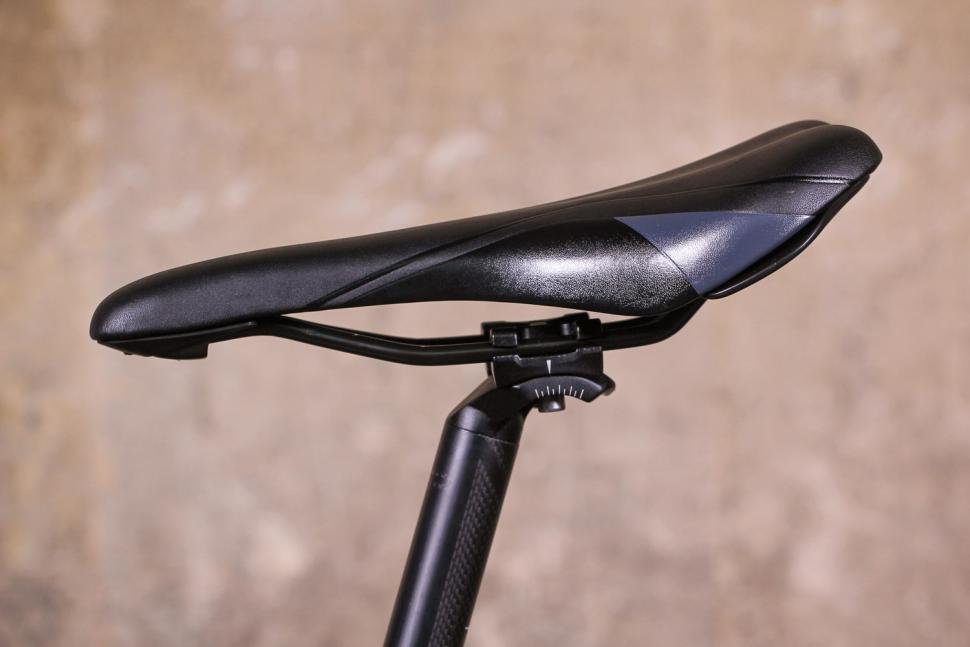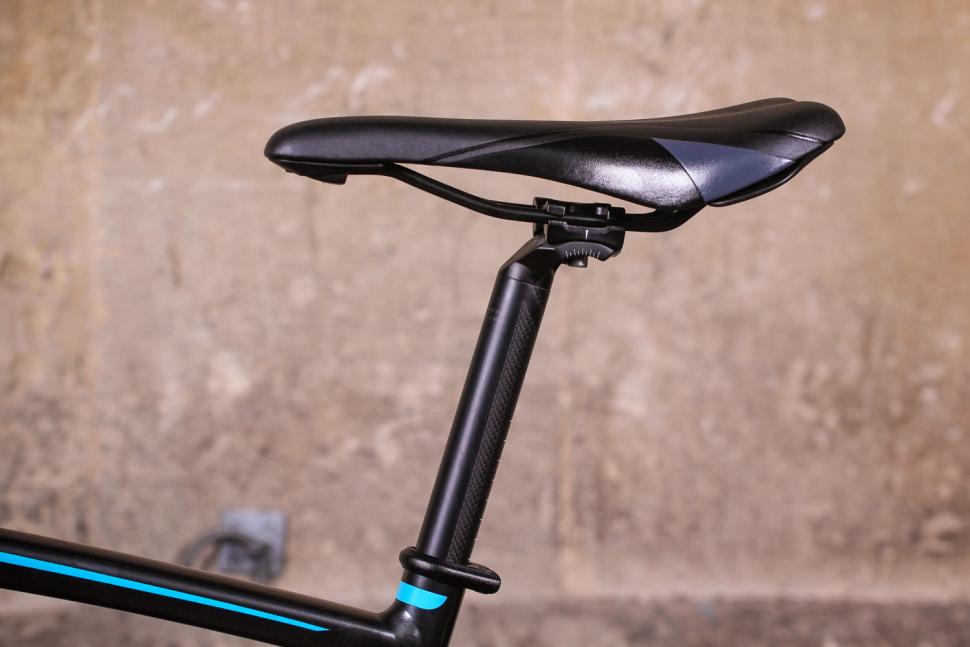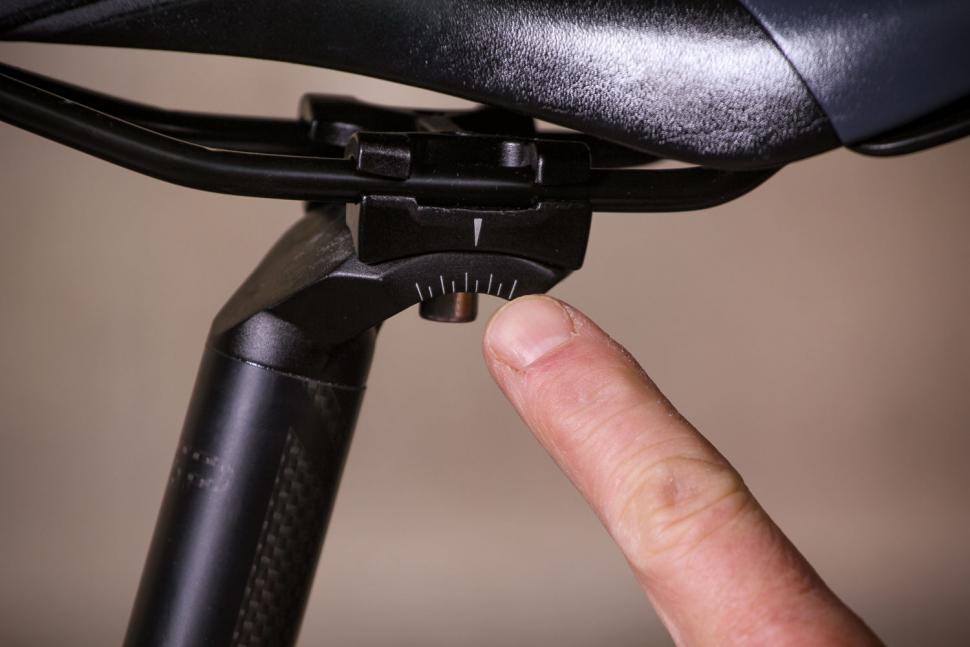- News
- Reviews
- Bikes
- Components
- Bar tape & grips
- Bottom brackets
- Brake & gear cables
- Brake & STI levers
- Brake pads & spares
- Brakes
- Cassettes & freewheels
- Chains
- Chainsets & chainrings
- Derailleurs - front
- Derailleurs - rear
- Forks
- Gear levers & shifters
- Groupsets
- Handlebars & extensions
- Headsets
- Hubs
- Inner tubes
- Pedals
- Quick releases & skewers
- Saddles
- Seatposts
- Stems
- Wheels
- Tyres
- Tubeless valves
- Accessories
- Accessories - misc
- Computer mounts
- Bags
- Bar ends
- Bike bags & cases
- Bottle cages
- Bottles
- Cameras
- Car racks
- Child seats
- Computers
- Glasses
- GPS units
- Helmets
- Lights - front
- Lights - rear
- Lights - sets
- Locks
- Mirrors
- Mudguards
- Racks
- Pumps & CO2 inflators
- Puncture kits
- Reflectives
- Smart watches
- Stands and racks
- Trailers
- Clothing
- Health, fitness and nutrition
- Tools and workshop
- Miscellaneous
- Buyers Guides
- Features
- Forum
- Recommends
- Podcast
TECH NEWS
 saddle tilt
saddle tiltTime to change The Rules? Tilting your saddle nose down by eight degrees is more efficient in seated-uphill efforts, researchers find
If you're a more discerning cyclist, you may be familiar with Rule #48 of the rather particular Velominati list of rules cyclists must abide by that says your saddle must be "visually level"... however some researchers are seriously challenging this, finding in a recent study that tilting your saddle nose down by eight degrees helps improve gross efficiency in seated-uphill efforts by an average of 1.4% compared to a parallel saddle position.
The study, titled ‘Nose-down saddle tilt improves gross efficiency during seated-uphill cycling’ by Ross D. Wilkinson and Rodger Kram, asked nineteen cyclists - who are described as “healthy, recreational” riders - to complete multiple five-minute seated efforts at 3W/kg on a large, custom-built cycling treadmill.
 In the testing, the treadmill was inclined to eight degrees under two saddle-tilt angle conditions: parallel to the riding surface, and with the saddle at a eight degree nose down angle.
In the testing, the treadmill was inclined to eight degrees under two saddle-tilt angle conditions: parallel to the riding surface, and with the saddle at a eight degree nose down angle.
“We measured subjects’ rates of oxygen consumption and carbon dioxide production using an expired-gas analysis system and then calculated their average metabolic power during the last two min of each 5 min trial,” the researchers say in the paper.
> 31 of the best cycling saddles for 2021 — get more comfortable on your road bike
The findings were that, compared to the parallel saddle position, tilting the saddle nose down by eight degrees improved gross efficiency from 0.205 to 0.208, which is an average increase of 1.4% across its testing participants.
The effect of saddle tilt on other slopes and the reasons behind the efficiency improvement have yet to be investigated, so we'll look forward to leafing through those findings at a later date; but nevertheless, the researchers say these initial findings are relevant to both competitive and recreational cyclists, and present an opportunity for innovating new devices and saddle designs that enhance uphill cycling efficiency.
> How to choose the correct saddle for you and your riding
As it stands, though, unless you’ve entered yourself into the local hill climb competition, cycling is not all about riding uphill... which most of us are thankful for! While it could be helpful to know that knocking your saddle down at the front is going to help you while your bike is tilted on an fairly steep incline, on the flat you’d have to recruit more of your core muscles to hold yourself in place.
> Find out about how to fit and set up your saddle to get your position right
 On the other hand, some riders may find they prefer a slight nose down saddle position regardless of the uphill efficiency benefits, as it can relieve some pressure on the rear of the perineum, albeit at the expense of added pressure on the feet and the hands. It also gives something to push back against and more easily develop a lower torso angle, for an aggressive aero position.
On the other hand, some riders may find they prefer a slight nose down saddle position regardless of the uphill efficiency benefits, as it can relieve some pressure on the rear of the perineum, albeit at the expense of added pressure on the feet and the hands. It also gives something to push back against and more easily develop a lower torso angle, for an aggressive aero position.
Chris Froome is certainly a rider who seems to be a fan of some saddle tilt…
As we mentioned above, the Velominati, who aim to “maintain the sacred text wherein lie the simple truths of cycling etiquette known as The Rules”, wholeheartedly disagree about the concept of titling your saddle, with RULE#48 boldly stating: "Saddles must be level and pushed back”.
Their full ‘reasoning’?
The seating area of a saddle is to be visually level, with the base measurement made using a spirit level.
Based on subtleties of saddle design and requirements of comfort, the saddle may then be pitched slightly forward or backward to reach a position that offers stability, power, and comfort.
If the tilt of the saddle exceeds two degrees, you need to go get one of those saddles with springs and a thick gel pad because you are obviously a big pussy.
The midpoint of the saddle as measured from tip to tail shall fall well behind and may not be positioned forward of the line made by extending the seat tube through the top of the saddle.
Are you a traditionalist like Velomanti, or will you now consider adjusting the tilt of your saddle based on these findings? Let us know in the comments as always.
Anna has been hooked on bikes ever since her youthful beginnings at Hillingdon Cycle Circuit. As an avid road and track racer, she reached the heady heights of a ProCyclingStats profile before leaving for university. Having now completed an MA in Multimedia Journalism, she’s hoping to add some (more successful) results. Although her greatest wish is for the broader acceptance of wearing funky cycling socks over the top of leg warmers.
Latest Comments
- David9694 2 sec ago
"Cyclists are permitted to visit Cornwall’s Household Waste and Recycling Centres (HWRCs). For safety reasons, pedestrians are not permitted at the...
- Rendel Harris 13 min 32 sec ago
Just a slight correction, 77 million US voters voted for Trump, 75 million for Kamala. If we assume that those who didn't vote for whatever reason...
- mitsky 15 min 49 sec ago
For anyone who is not a fan of NF (funny how those initials turned out, eh?)......
- Rendel Harris 17 min 56 sec ago
I see. Supplementary question as you clearly know more about it than I do, how do foam inserts work with different pressures, e.g. if they drop the...
- DannyWheels 18 min 26 sec ago
Hi, did this clamp work or did you manage to find something? I have the exact same issue with my Former Flash Road Bike
- Rome73 2 hours 11 min ago
https://thebikeproject.co.uk/ this project in London does the same - if anyone has any unused bikes they would like to donate.
- ktache 11 hours 3 min ago
Quest are showing the Paris Roubaix highlights at 11 both days.
- chrisonabike 11 hours 48 min ago
Pretty sure a lot of that "more space for motor vehicles" was because fewer motor vehicles (also marginally "smaller motor vehicles")....
- thax1 13 hours 13 min ago
Cycliq certainly seemed to let a lot of people down in the early days. I held off until the 12 Sport came out, but have been impressed....
- ktache 13 hours 15 min ago
My better half seems to like giving me pressies of Rapha clothing. I am wearing their casual hoodie right now, and very nice it is too. First off...
Add new comment
45 comments
There is a company... I think in canada, making a quick tilt adjustment for mountain biking. I had thought it could be really nice to have it on a road bike for the long climbs in the alps here. Even on short climbs if i can click a lever on the bar like you would a dropper post. Even without this gadget, i have startex dropping the nose of my saddle though. 1.5 hrs up for 25 min down on one of my favorites justifies this setting.
Anyone quoting 'The Rules' deserves a smack in the mouth.
You literally just put the words _The_ and _Rules_ within some quote marks, thus you need to smack yourself in the mouth!
(Notice that I specifically did not "quote" them)
You quoted PMacB quoting them. I think that means you double quoted them, so you get two smacks.
Dagnammit!
Nominations for this years Nobel prize for physics are now closed
Sounds like the right thing to do if you, er, only ride uphill.
A constant 8% hill at that.
I set my saddle for riding comfort, not for tiny power increases with limited circumstances; as for Froome, his bike is ridden at extreme bent over angle, so he would need a downward tilt to prevent crush injury of a certain part of his anatomy.
This is a GREAT idea from this very well thought out article. So from now one I will take a leveler and a tool for the seat bracket bolt, then when I'm climbing a hill I will stop and tilt the saddle nose down, when I get to the top I will stop and put it back where it was, I will just keep doing that as I ride up and down hills...
And when you stop to adjust your saddle you can put your climbing specific jersey on and put some absolute cack chain lube on and save another fraction of a watt, pretty soon you will be so fast up hill you will need your brakes on.
I think it'd be far more efficient to have a seatpost and saddle ready with an 8 deg down slope for climbing, a flat one for level riding and maybe one with an 8 deg upslope for descending. Just change them over with the QR when you need them.
You could carry the spare saddle/seatpost at the back of the bike somewhere
Basically, yes:
https://youtu.be/SxijmGRKH2k
Credits: Jack Sexty (see lower down the posts)
So when riding up hill having a (currently) level saddle is best?
On the flat is a downward sloping saddle best? probably not.
So do we want to trade less comfort for most of the time to be slightly more efficient going up hills?
Maybe if I was riding up ventoux, but not for tha majority of rides.
Who gives any credence to the velominati ? Ignore them. Ride your bike.
Sorted.
As a slide-forwards type of a cyclist - not for me.
As for numbness, any decent saddle these days has a decent trough for pressure relief, haven't had that problem for years now.
The other question is relative handlebar height. As a pro, we can see from the picture that Froomey already has a significantly different posture (interesting how shallow his drops are on that bike) and does the study account for this? As people are using some sort of test frame and do they get a choice about setting handlebar height - if they are having to use a pro-style drop position then it would not be surprising that an inclination might help... and what incination does it affect, are we talking 2%, 10% or what? (Edit, ah! 8 degrees for 8 degrees of climbing) What is its impact on level cycling?
All in all, without knowing what other parameters were being set for the "bike fit" ascribing so much efficiency to a simple saddle angle change seems dubious, because surely this will imply a different leg position leading to wanting to adjust other elements of the fit.
Ooh just imagine if Diana Ross had eight degrees on her saddle instead of a measly three..
Interesting read, the actual paper, the highlights of which are;
1) a reduction in numb-nut syndrome - in sci-speak "nose-down saddle tilt maintained non-pathological latency and sensory conduction velocity in the pudendal nerve".
2) The increase in efficiency would mean that an elite climber could break the current Alpe D'Huez 13.8 km climbing record of 37' 38" by 26".
Olympic MTB Champ Kulhavy used to ride with an extreme (-14 degree seat position)
Am I missing something here? The saddle remains at the optimum (zero) tilt relative to the horizon whilst the ground beneath and the bicycle with it is tilted up by 8 degrees.
So you're saying the seat post needs to have a "self-levelling" mechanism that constantly tracks the incline being ridden?
It can't do declines though as that could be quite painful.
This is going to need a complete redesign!
Dropper post gimball?
No, I'm not saying the seat needs a self levelling mechanism. I'm saying that is basically what they've done here; pitched the seat down by the same amount the slope pitches up. So effectively the saddle stays at a horizontal attitude relative to gravity or the horizon. Your bum in the saddle feels it is level.
It is the same logic that says the floor in a funicular rail carriage is angled down (usually in a series of steps) by the same amount that the railway line slopes up - so the floor remains horizontal in use.
But if the report's findings are sound then why not go for the saddle levelling adjustment, like a dropper post?
thats how I read it, and they have not assessed the impact on efficiency of thesame change when riding on flat roads
Sorry to be a huge nerd here, but it's not "3W/kg-1".
It's either 3W/kg, or 3W.kg^-1 (should be superscript -1).
Meanwhile, physios and bike fitters across the world rub their hands with glee at the extra custom soon to come their way...
So I now need a "tilter" seat clamp along with my dropper seat post?
On the other hand if you're cruising generally the opposite is true (tilt up more comfortable for upright position).
Maybe we should just dispense with seats and seat posts entirely? More aero and saves weight!
Interesting!
I used to have my saddles with quite a big downward tilt on them as I found that most comfortable. Then after getting a bike fit and experimenting with position, I tried to gradually adjust to having the saddle more level (follow The RULES!), but I still find saddles more comfortable with a tilt of somewhere around 3-5°.
My saddles have always been ever so slightly nose up.
If I have them level or nose down then I seem to spend my life shuffling myself back toward the back of the saddle.
I found that a big problem with having my saddle tilted too far forwards was then having too much weight on my hands and getting numb fingers after a while. During the bike-fit, the fitter recommended changing to a wider saddle as my sit bones are quite wide and that the saddle tilt was a way of adapting to a narrow saddle (not quite sure how that works, but I think it moves the contact point further back towards the wide end).
Pages